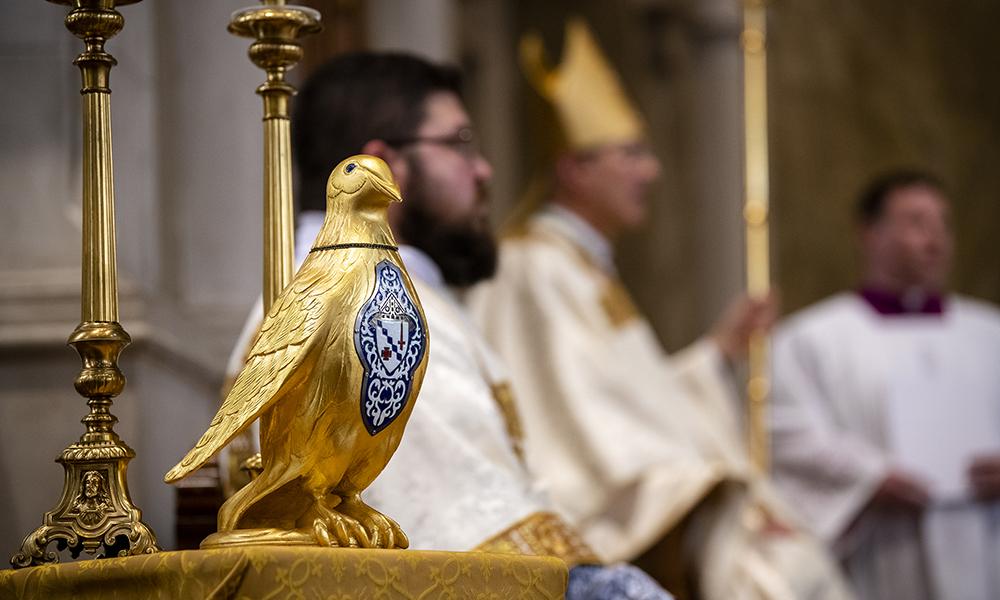
A new Chrism Ampulla for Birmingham
Bishop Steven Raica recently commissioned a Holy Chrism Ampulla for use in diocesan sacred liturgies.
Ampullae were popular in ancient times for the transportation of oil, and in the early Church, holy oil was gathered from lamps in the shrines of martyrs and the sites of pilgrimage. In addition, small ampulla vessels were among the many objects part of catacomb burials. Whether they contained Holy Water, holy oil, or the blood of martyrs, the purpose of ampullae were to hold something sacred.
Ampullae were made of a variety of materials like terracotta, metal, and glass, and were decorated with Christian symbols and inscriptions. Numerous ampullae, both historically documented and extant, reveal their importance in the Church’s liturgical life.
The Sainte Ampoulle, sadly lost during the French Revolution, was used at the consecration of the kings of France in the Cathedral of Reims. It was popularly believed to have been brought from Heaven by a dove at the baptism of Clovis (496). In the Cathedral of Monza, several ampullae are preserved that were sent to Queen Theodolinda by Pope Gregory the Great; they contained oil from the tombs of Roman martyrs. In England, a golden eagle ampulla from the 17th century is part of Monarch’s Consecration. Its design is based on a 14th century legend in which the Blessed Virgin Mary appeared to St. Thomas Becket and presented him with a golden eagle oil vial for anointing future kings of England.
Among the most important extant ampullae is one commissioned by the great medieval visionary Abbot Suger of Saint-Denis in the 12th century. Held in the Louvre Museum, the ampulla known as Suger’s Eagle, combines an ancient 2nd century porphyry vase to a 12th century silver-gilt eagle. It most likely held the Sacred Chrism.
In discussing the many wondrous things he provided for the church at Saint-Denis, Abbot Suger (1081-1151) succinctly wrote the following about sacred vessels and their fashioning for use in the sacred liturgy:
“To me, I confess, one thing has always seemed preeminently fitting: that every costlier or costliest thing should serve, first and foremost, for the administration of the Holy Eucharist. If golden pouring vessels, golden vials, golden little mortars used to serve, by the word of God or the command of the Prophet, to collect the blood of goats or calves or the red heifer: how much more must golden vessels, precious stones, and whatever is most valued among all created things, be laid out, with continual reverence and full devotion, for the reception of the blood of Christ! Surely neither we nor our possessions suffice for this service. If, by a new creation, our substance were reformed from that of the holy Cherubim and Seraphim, it would still offer an insufficient and unworthy service for so great and so ineffable a victim; and yet we have so great a propitiation for our sins. The detractors also object that a saintly mind, a pure heart, a faithful intention ought to suffice for this sacred function; and we, too, explicitly and especially affirm that it is these that principally matter. [But] we profess that we must do homage also through the outward ornaments of sacred vessels, and to nothing in the world in an equal degree as to the service of the Holy Sacrifice, with all inner purity and with all outward splendor. For it behooves us most becomingly to serve Our Saviour in all things in a universal way — Him Who has not refused to provide for us in all things in a universal way and without any exception; Who has fused our nature with His into one admirable individuality; Who, setting us on His right hand, has promised us in truth to possess His kingdom; our Lord Who liveth and reigneth for ever and ever.”
The Birmingham ampulla was made by New Guild Studio Inc. of Pittsburgh, PA and was inspired by an ampulla from the Treasury of Notre Dame Cathedral, Paris, made by Viollet-le-Duc in 1866. The Birmingham ampulla is in the shape of a dove recalling the Holy Spirit. It is hand-carved from linden wood and measures 16 inches tall. Set with hand-blown lapis glass eyes, the ampulla is gilded in 24kt gold leaf and features a hand chased, fired enamel breast plate on the front featuring the coat of arms of the Diocese of Birmingham. Ingeniously engineered, an embedded magnetic plate at the head allows practical access to the Holy Chrism vial inside.
The Birmingham ampulla will be used and carried in procession for Episcopal Ceremonies such as the Chrism Mass, ordinations, confirmations, and other liturgies in which Holy Chrism is used.
Father Jordan Hainsey of the Diocese of Covington and Father Justin Ward, Episcopal Master of Ceremonies and Vicar for Sacred Liturgy for the Diocese of Birmingham, offered artistic direction on the project.



